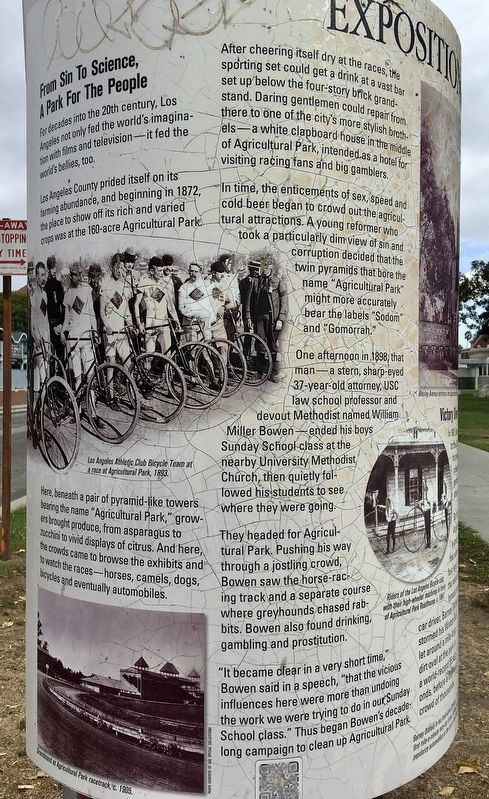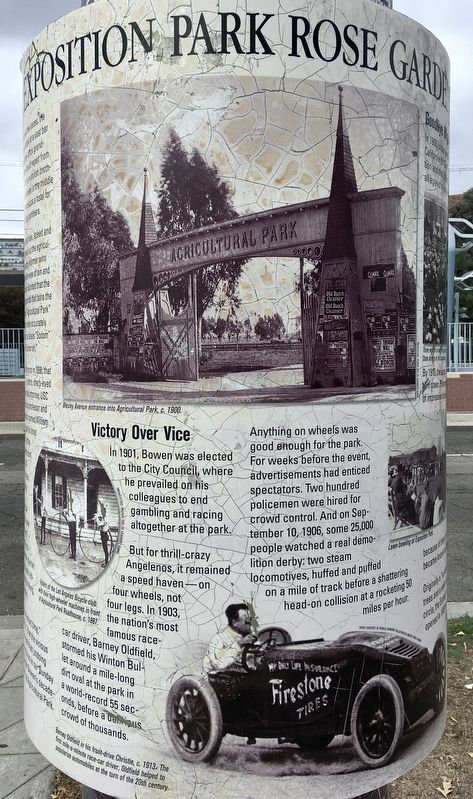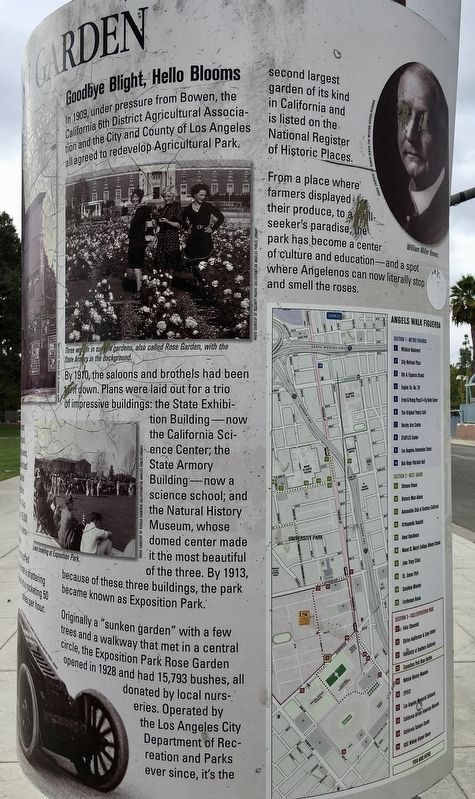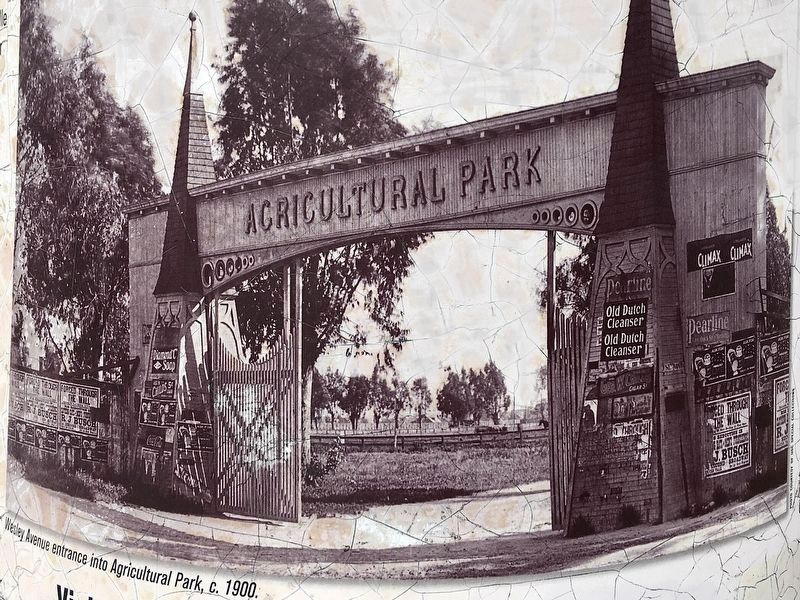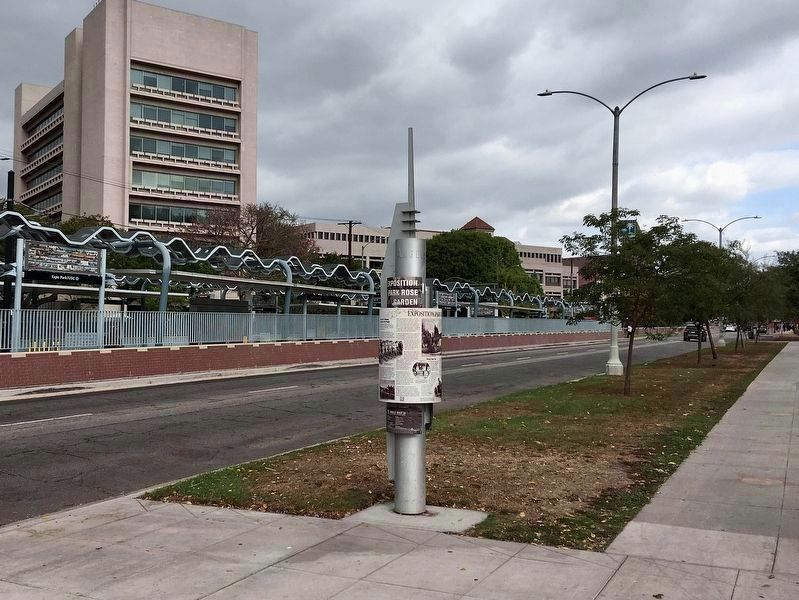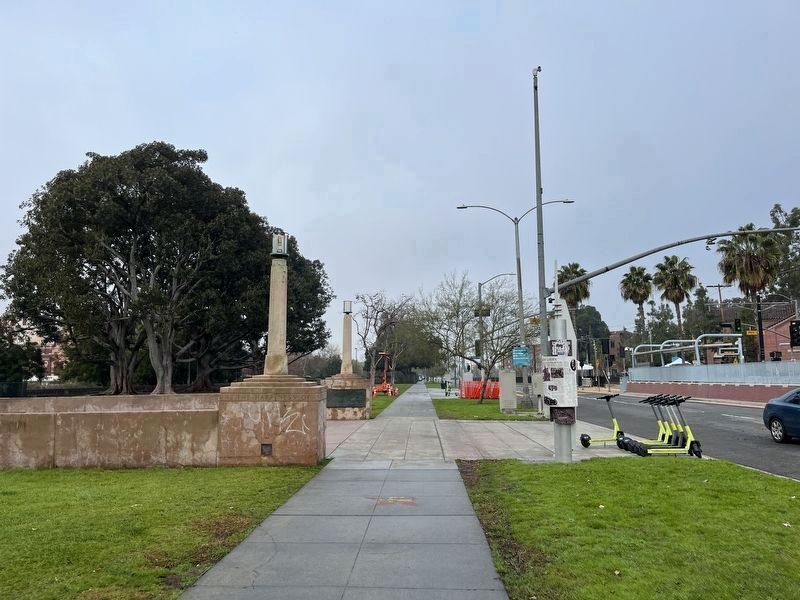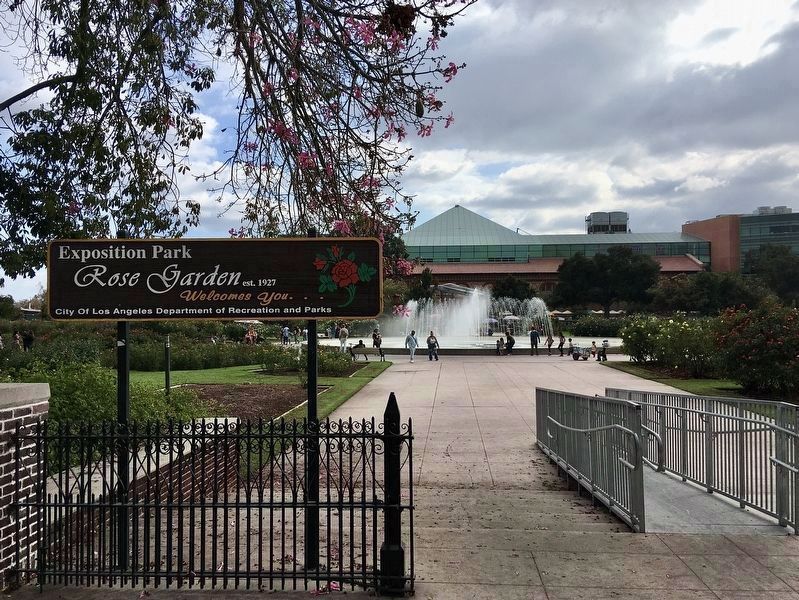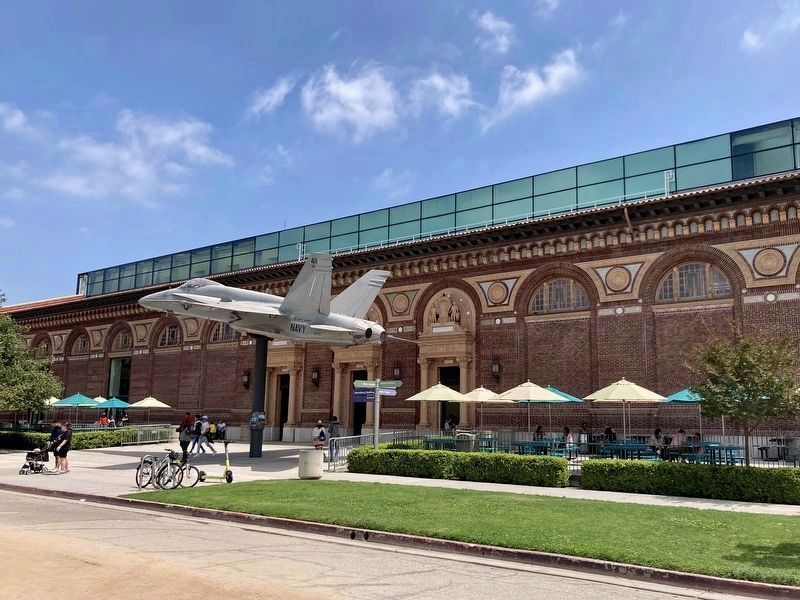South Los Angeles in Los Angeles County, California — The American West (Pacific Coastal)
Exposition Park Rose Garden
From Sin to Science, A Park For The People
For decades into the 20th century, Los Angeles not only fed the world’s imagination with films and television — it fed the world’s bellies, too.
Los Angeles County prided itself on its farming abundance, and beginning in 1872, the place to show off its rich and varied crops was the 160-acre Agricultural Park.
Here, beneath a pair of pyramid-like towers bearing the name “Agricultural Park”, growers brought produce, from asparagus to zucchini to vivid displays of citrus. And here, the crowds came to browse the exhibits and watch the races — horses, camels, dogs, bicycles and eventually automobiles.
After cheering itself dry at the races, the sporting set could get a drink at a vast bar set up below the four-story brick grandstand. During gentlemen could repair from there to one of the cities more stylish brothels – a white clapboard house in the middle of agricultural park, intended as a hotel for visiting racing fans and big gamblers.
In time, the enticements of sex, speed and cold beer began to crowd out the agricultural attractions. A young reformer who took a particularly dim view of sin and corruption decided that the twin pyramids that bore the name “Agricultural Park” might more accurately bear the labels “Sodom” and “Gomorrah.”
One afternoon in 1898, that man — a stern, sharp-eyed 37-year-old attorney, USC law school professor and devout Methodist named William Miller Bowen — ended his boys Sunday School class at the nearby United Methodist Church, then quietly followed his students to see where they were going.
They headed for Agricultural Park. Pushing his way through a jostling crowd, Bowen saw the horse-racing track and a separate course where greyhounds chased rabbits. Bowen also found drinking, gambling and prostitution.
“It became clear in a very short time,” Bowen said in a speech, “that the vicious influences here were more than undoing the work we were trying to do in our Sunday School class”. Thus began Bowen’s decade-long campaign to clean up Agricultural Park.
Victory over Vice
In 1901, Bowen was elected to the City Council, where he prevailed on his colleagues to end gambling and racing altogether at the park.
But for thrill-crazy Angelenos, it remained a speed haven — on four wheels, not four legs. In 1903, the nation’s most famous race-car driver, Barney Oldfield, stormed his Winton Bullet around a mile-long dirt oval at the park in a world-record 55 seconds, before a delirious crowd of thousands.
Anything on wheels was good enough for the park. For weeks before the event, advertisements had enticed spectators. Two hundred policeman were hired for crowd control. And on September 10, 1906, some 25,000 people watched a real demolition derby: two steam locomotives huffed and puffed on a mile of track before a shattering head-on collision at a rocketing 50 miles per hour.
Goodbye Blight, Hello Blooms
In 1909, under pressure from Bowen, the California 6th District Agricultural Association and the City and County of Los Angeles all agreed to redevelop Agricultural Park.
By 1910, the saloons and brothels had been torn down. Plans were laid out for a trio of impressive buildings: the State Exhibition Building — now the California Science Center; the State Armory Building — now a science school; and the Natural History Museum, whose domed center made it the most beautiful of the three. By 1913, because of these three buildings, the park became known as Exposition Park.
Originally a “sunken garden“ with a few trees and a walkway that met in a central circle, the Expedition Park Rose Garden opened in 1928 and had 15,793 bushes, all donated by local nurseries. Operated by the Los Angeles City Department of Recreation and Parks ever since, it’s the second largest garden of its kind in California and is listed on the National Register of Historic Places.
From a place where farmers displayed their produce, to a thrill-seeker’s paradise, the park has become a center of culture and education — and a spot where Angelenos can now literally stop and smell the roses.
Erected 2005 by City of Los Angeles.
Topics and series. This historical marker is listed in these topic lists: Entertainment • Horticulture & Forestry • Parks & Recreational Areas • Sports. In addition, it is included in the National Register of Historic Places series list. A significant historical year for this entry is 1872.
Location. 34° 1.082′ N, 118° 17.163′ W. Marker is in Los Angeles, California, in Los Angeles County. It is in South Los Angeles. Marker is on Exposition Boulevard, 0.3 miles east of Vermont Avenue, on the right when traveling east. Touch for map. Marker is in this post office area: Los Angeles CA 90037, United States of America. Touch for directions.
Other nearby markers. At least 8 other markers are within walking distance of this marker. Citius Altius Fortius (a few steps from this marker); Exposition Park and USC (within shouting distance of this marker); Mudd Memorial Hall (about 300 feet away, measured in a direct line); Rose Garden (about 400 feet away); Rainbow Division (about 400 feet away); F/A-18A Hornet (about 600 feet away); Teaching and Learning (about 600 feet away); Town and Gown of USC (about 700 feet away). Touch for a list and map of all markers in Los Angeles.
Regarding Exposition Park Rose Garden.
Added to the National Register of Historic Places in 1991.
Also see . . . Angels Walk L.A. Self-guided walking tours of historic neighborhoods in Los Angeles. The Exposition Park Rose Garden marker is part of the Figueroa walk. (Submitted on October 26, 2022.)
Credits. This page was last revised on October 14, 2023. It was originally submitted on October 26, 2022, by Craig Baker of Sylmar, California. This page has been viewed 204 times since then and 35 times this year. Last updated on February 24, 2023, by Adam Margolis of Mission Viejo, California. Photos: 1, 2, 3, 4, 5. submitted on October 26, 2022, by Craig Baker of Sylmar, California. 6. submitted on February 12, 2023, by Adam Margolis of Mission Viejo, California. 7. submitted on October 26, 2022, by Craig Baker of Sylmar, California. 8. submitted on June 24, 2023, by Craig Baker of Sylmar, California. • J. Makali Bruton was the editor who published this page.
